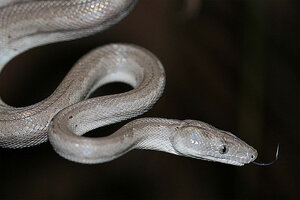New silvery snake species slithers onto sleeping scientist
Scientists have discovered a new variety of boa in the Bahamas that might already face extinction.

This species of boa, Chilabothrus argentum, was just discovered and is already endangered.
Courtesy of R. Graham Reynolds
Zoologists dream of discovering a new species, but it's rare that one pops up right in front of – or on – their noses. But that's how a team of herpetologists discovered a new boa in the Bahamas.
The researchers were surveying remote islands looking for lizards. As evening descended on a tiny island, one of the scientists spotted a snake and called the rest of the team over.
There, perched in a silver palm tree, was a three-foot long silvery snake.
"As soon as we saw it, we knew that we had found something different," says R. Graham Reynolds, who was leading the team as a postdoctoral fellow at Harvard University's Museum of Comparative Zoology at the time. But "we didn't know how different until we came back to the lab."
Dusk was falling, but the team searched excitedly for more of these strange boas. That night they found and catalogued five specimens.
The scientists still had a few hours before a boat was set to pick them up from the island, so they decided to take a nap on a beach near the forest.
At about 3:30 in the morning, "I woke up with something crawling across my face," Dr. Reynolds recalls. "And it was specimen number six."
Perhaps the snake was attracted to the scientist's body heat, or maybe it was curious about the human's smell, Reynolds says. Or maybe he was simply in its path.
"I was in a sort of daze," Reynolds, who is now at the University of North Carolina Asheville, tells The Christian Science Monitor. "I put it in a little cloth bag that I had, tied it up, and went back to sleep."
"As I lay back down I thought, when I wake up in the morning there will be a stick in the bag. I probably just imagined this whole thing," he says. But sure enough, the snake was still a snake in the morning.
Reynolds and his colleagues suspected that these snakes represented a new species because they were physically quite distinct from others known in the Bahamas.
In addition to observing and measuring the snakes, they took genetic samples. The DNA was the "smoking gun," Reynolds says: they had found a new species.
And not just any new species. These distinctive serpents diverged from their closest known relatives about 2.7 million years ago, he says.
The scientists named the new species the silver boa, Chilabothrus argentum. It is important to note that these boas are not the same as boa constrictors. Although they are members of the same taxonomic family, boa constrictors, which can grow as long as 10 feet, are members of the genus Boa, whereas the silver boa, which is about three feet long, is a member of the genus Chilabothrus. The researchers describe Chilabothrus argentum in a paper published on Friday in the journal Breviora.
"Boas as a group are not incredibly species rich compared to some other groups or even genera of snakes, and so finding a new one is actually a pretty big deal since there isn't a lot of species diversity to start with," Sara Ruane, a herpetologist at the Louisiana State University Museum of Natural Science, who was not a part of the research team, says in an interview with the Monitor.
And this is "a pretty sizable animal," she says. "It's just wild to me that this snake has been out there for a long time and nobody has come across it."
"It goes to show that we still don't know what's out there on every square inch of the Earth," Dr. Ruane says.
This new boa is silvery in color with faint patterns. These snakes spend a lot of time in trees and seem to prefer to eat birds, Reynolds says.
Previously, researchers knew of just three species of boas native to the Bahamas and Turks and Caicos, he says. "This will be the fourth endemic species to that region." The other boas have bolder colors and patterns, live on both the ground and in trees, and have a more varied diet.
Reynolds has visited the silver boas' island three times to learn more about the new species. And he has discovered that life is not going along smoothly for the snakes.
"It seems that we've discovered them as they're on their way to extinction," Reynolds says. His research team has determined that the silver boa is critically endangered, according to criteria from the International Union for Conservation of Nature Red List.
"We think that there's probably fewer than a thousand of these animals left," Reynolds says.
Of course, those small numbers could be explained by their incredibly small range. The boas were discovered on Conception Island, which is about 2.7 square miles. And, despite searching for them, Reynolds says they have not been found on any other islands in the region.
What's decimating this newfound species? Likely cats, says Reynolds.
"We discovered on the second trip that there are feral cats," presumably left behind by humans visiting the now-uninhabited island, Reynolds explains. "Cats are really devastating for island wildlife and these boas in particular. The boas have no defense against the cats, and the cats just eat them."
Fortunately, the island is protected by the Bahamas National Trust, Reynolds says, which will take action to protect the boas.
"I think the first thing that will have to happen," he says, "is find a way to get those cats off the island."


